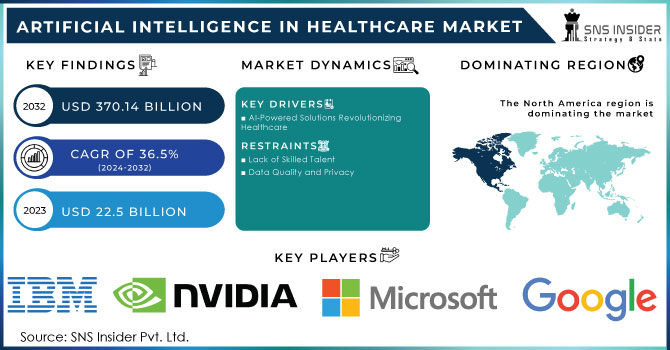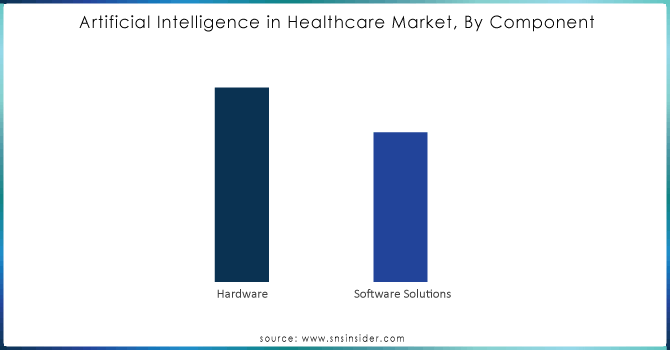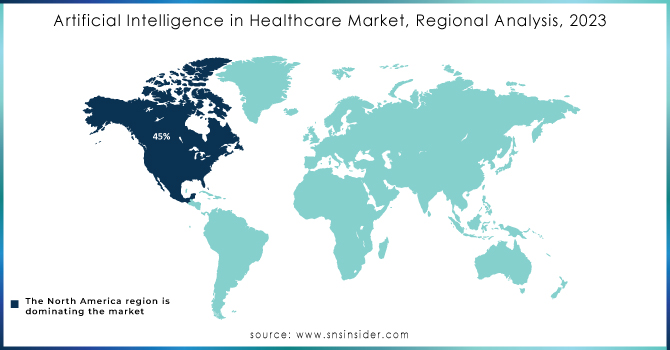Artificial Intelligence (AI) in Healthcare Market Size Analysis
The Artificial Intelligence in Healthcare Market Size was valued at USD 22.5 Billion in 2023 and is expected to reach USD 370.14 billion by 2032 and grow at a CAGR of 36.5%over the forecast period 2024-2032.

Get more information on Artificial Intelligence In Healthcare Market - Request Sample Report
Artificial Intelligence (AI) in Healthcare: Revolutionizing Patient Outcomes and Operational Efficiency
Artificial Intelligence (AI) is swiftly converting the healthcare industry, further providing unique opportunities to enhance patient outcomes, improve operational efficiency, and decrease costs. As healthcare players are struggling with the surging demand and the ability of AI to analyze large amounts of data, make accurate predictions, and patterns identification has become a strategic driver for market expansion.
AI Impact on Healthcare: Enhancing Accuracy, Efficiency, and Patient Outcomes
The main driving factor for market growth is the urgent need for enhanced accuracy, efficiency, and patient outcomes. AI-powered solutions help in automating the routine tasks, improving diagnostic accuracy, and allow personalized treatment plans. For instance, AI algorithms are able to analyze medical images to detect anomalies more accurately, which leads to earlier diagnosis and treatment. This growth of healthcare data, coupled with the global healthcare professionals’ shortage, has created a surging need for innovative solutions.
Competitive Landscape: An Increase in AI Players in Healthcare
The artificial intelligence in healthcare market is experiencing a rapid growth in players, such as technology giants, established healthcare providers, and startups. These leading players in the market are developing a large range of AI-powered solutions, from diagnostic tools to predictive analytics platforms. Competition is intense, with companies vying to differentiate their offerings and capture artificial intelligence in healthcare market share. Factors including technological innovation, partnerships, and product quality, with healthcare providers that are the major determinants of success.
AI Transforming Healthcare: From Support for Clinical Decision to Drug Discovery
AI is revolutionizing different healthcare aspects, starting from clinical decision support to drug discovery and also medical imaging. By analyzing large number of data, the AI-powered tools help healthcare providers in making informed decisions, further boosting the drug development, enhance diagnostic accuracy, and optimize resource allocation for population health management.
Navigating the Regulatory and Ethical Healthcare AI Landscape
The regulatory and ethical landscape of healthcare AI is complex. Data quality and privacy are at the paramount for preventing patient information and maintain trust. To protect sensitive data, adherence to regulatory frameworks, such as GDPR HIPAA are necessary. Furthermore, the ethical AI implications, such as transparency and accountability, should be considered carefully to ensure proper use of technology.
Artificial Intelligence in Healthcare Market Dynamics:
Drivers:
- AI-Powered Solutions Revolutionizing Healthcare Propel Market Expansion
To address workforce shortages and improve patient outcomes are the initial artificial intelligence in healthcare market growth drivers. The high growth for the global shortage of healthcare professionals and healthcare data have generated a strong requirement for AI-powered solutions. AI also improves the diagnostic accuracy, offer personalized care, total patient outcomes, and minimize costs. Recent advancements in AI have revolutionized healthcare.
AI models, such as AlphaFold boosts the drug discovery by forecasting protein structures, as AI-powered medical imaging improves diagnostic accuracy. Personalized treatment plans that are based on AI-assisted surgery and individual patient data, which provide enhanced precision and decreased recovery times. AI-powered virtual therapists and chatbots offer accessible mental health particularly in the underserved regions. To ensure ethical AI use, there is a surging focus on developing unbiased, fair, and transparent AI systems in the healthcare industry.
Restraints
- Lack of Skilled Talent and Data Quality and Privacy Hamper Market Growth
To ensure the privacy and quality of healthcare data has been important for effective AI implementation. Poor data quality can hamper the accuracy of AI models, as privacy concerns can possibly limit data availability and hinder research.
AI in Healthcare Market Segmentation Overview
By Component
The software solution component segment led the market in 2023 with a market share of 38.7% due to the increasing AI-based software solutions adoption among various healthcare providers, patients, and payers. For instance, several Chinese software developers and GE Healthcare, in September 2019, have partnered to create Edison AI platform, highlighting the AI adoption trend in healthcare industry.
The services component is expected to grow, fueled by the expanding penetration of AI-based technologies in various healthcare applications. The applications include virtual assistants, clinical trials, decrease in dosage error, surgeries assisted by robots, and detection of frauds. The increasing demand for AI-related services, including implementation, consulting, and maintenance, is also contributing to the expansion of the segment.

Need any customization research on Artificial Intelligence in Healthcare Market - Enquire Now
By Application
The robot assisted application segment held the dominant market share of around 22.0% in 2023 due to the factors, such as surge in robot-assisted surgeries and propelled funding for the development of AI platform. Intuitive Surgical, which is a leading provider of surgical robotics, reported robust Q1 2023 results, with an increased revenue of 14% year-over-year, caused by the 26% surge in robotic procedures.
This high demand highlights the growing trained professionals’ requirement in the market.
The increased growth the robot-assisted surgery is primarily driven by the shortage of skilled surgeons. AI-powered technologies help surgeons to perform difficult procedures with better accuracy and precision, substantially tackling the challenges caused by the limited surgical expertise supply globally.
By Technology
Machine Learning (ML): The machine learning technology segment dominated the market in 2023 with 35.6% market share. The healthcare industry generates massive amounts of data, including electronic health records (EHRs), medical imaging, genomic data, and wearable device data. Machine Learning makes extraction valuable insights easy from the datasets, further helping healthcare companies make strategic data-driven decisions and along with enhancing patient results.
ML is widely integrated into healthcare solutions for disease diagnosis, prognosis, and treatment planning. By analyzing patient data patterns and correlations, ML models detect early disease indicators, forecast patient outcomes, and propose personalized treatment strategies, enhancing the accuracy and timeliness of interventions.
The Natural Language Processing (NLP) technology segment is expected to witness substantial growth during the forecast period. NLP helps in optimizing and automating clinical documentation processes, such as coding, charting, and medical transcription. NLP boost the documentation workflows, decrease administrative pressure, ensure billing and reimbursement accuracy by automatically coding and extracting related data from clinical narratives.
By End-User
In 2023, the healthcare companies segment led the market with a total share of 32.2% due to the large AI technologies adoption in the drug development process. AI enables personalized treatment options and target therapies for some specific patient groups by leveraging genomic data, clinical trial data, and medical records. AI-driven analytics and predictive modeling are also responsible for enhancing the clinical trials' cost-effectiveness and efficiency. A January 2024 study by Scilife N.V. found that approximately 80% of the life sciences and pharmaceutical professionals that are using AI for drug discovery. Research suggests that AI technology can reduce the time required to discover new drugs from 5-6 years to just one year. The research also suggests that AI technology can decrease the required time for discovering new drugs from 5-6 years to one year.
The healthcare providers segment is projected to witness substantial expansion during the forecast period as the medical imaging tools assist the healthcare providers in interpreting medical images, enhance diagnostic accuracy, reduce interpretation time, and facilitating the detection of early diseases. Hospitals are also utilizing predictive analytics driven by AI to propel the rates of patients, along with identification of AI-related risks, and offer resources effectively, further propelling the growth of the segment.
AI in Healthcare Market Regional Insights
North America
The North American AI in the healthcare market, led by the U.S., maintained a dominant position, accounting for over 45% of global revenue in 2023. The region's growth is attributed to advancements in healthcare IT infrastructure, surging healthcare expenditures, presence of major market players, and high AI/ML adoption, along with favorable government initiatives. The surging geriatric population, burgeoning chronic diseases' prevalence, and changing lifestyles, along with the augmenting demand for value-based care, drives the market growth in this region.
Europe
The European AI in healthcare market is experiencing significant growth, driven by the widespread adoption of AI technologies and increased investments from both government and private organizations. The UK, in particular, has made significant strides in AI adoption within the National Health Service (NHS), leveraging AI for medical imaging analysis, predictive analytics, and personalized treatment planning.
Asia Pacific
The Asia Pacific AI in healthcare market is projected to witness substantial growth in the coming years. This growth is fueled by rapid innovations in IT infrastructure and the emergence of AI-focused entrepreneurship ventures. Increased investments from private investors, venture capitalists, and non-profit organizations drive adoption rates, while favorable government initiatives further boost market growth. China, with its increased AI adoption for diagnosis, medical imaging, and robot-assisted surgeries, has emerged as a key market player in the region.

Key Players:
Some of the major artificial intelligence in healthcare market companies are Enlitic, Inc., General Vision, Inc., IBM Corporation, Google Inc., Intel Corporation, Microsoft Corporation, Next IT Corporation, iCarbonX, Welltok, Inc., Nvidia Corporation and other players.
Recent Developments in AI in Healthcare Industry
Google DeepMind:
- February 2024: DeepMind's AlphaFold 2 successfully predicted the structures of almost every protein known to science, a breakthrough that could revolutionize drug discovery.
- June 2024: Announced a collaboration with the UK National Health Service (NHS) to develop AI tools for early detection of diseases like cancer and heart disease.
IBM Watson Health:
- March 2024: Launched a new AI-powered platform for clinical trials, designed to accelerate drug development and improve patient outcomes.
- May 2024: Announced a partnership with the Cleveland Clinic to develop AI-based solutions for predicting patient outcomes and optimizing care delivery.
Microsoft:
- January 2024: Launched a new AI-powered platform for medical imaging, designed to improve diagnostic accuracy and efficiency.
- March 2024: Announced a partnership with the Mayo Clinic to develop AI-based solutions for personalized medicine.
| Report Attributes | Details |
|---|---|
| Market Size in 2023 | US$ 22.5 Billion |
| Market Size by 2032 | US$ 370.14 Billion |
| CAGR | CAGR of 36.5% From 2024 to 2032 |
| Base Year | 2023 |
| Forecast Period | 2024-2032 |
| Historical Data | 2020-2022 |
| Report Scope & Coverage | Market Size, Segments Analysis, Competitive Landscape, Regional Analysis, DROC & SWOT Analysis, Forecast Outlook |
| Key Segments |
• By Component (Hardware, Software Solutions, Services) |
| Regional Analysis/Coverage | North America (US, Canada, Mexico), Europe (Eastern Europe [Poland, Romania, Hungary, Turkey, Rest of Eastern Europe] Western Europe] Germany, France, UK, Italy, Spain, Netherlands, Switzerland, Austria, Rest of Western Europe]), Asia Pacific (China, India, Japan, South Korea, Vietnam, Singapore, Australia, Rest of Asia Pacific), Middle East & Africa (Middle East [UAE, Egypt, Saudi Arabia, Qatar, Rest of Middle East], Africa [Nigeria, South Africa, Rest of Africa], Latin America (Brazil, Argentina, Colombia, Rest of Latin America) |
| Company Profiles | Enlitic, Inc., General Vision, Inc., IBM Corporation, Google Inc., Intel Corporation, Microsoft Corporation, Next IT Corporation, iCarbonX, Welltok, Inc., Nvidia Corporation. |
| Key Drivers | • AI-Powered Solutions Revolutionizing Healthcare |
| Restraints |
• Lack of Skilled Talent |

